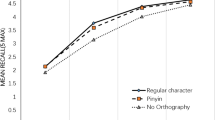Abstract
Most controlled studies of facilitated communication (FC) have not validated it. One task, however, on which positive effects of FC have been demonstrated without facilitator influence is the Peabody Picture Vocabulary Test-R (PPVT-R). The present study investigated if the use of FC could be validated for either a group of subjects with autism or a group with severe to profound cognitive impairments, on the PPVT-R when facilitators were effectively screened from all visual and auditory stimuli. Additionally, the effect of mode of inputauditory or visual-on subjects' performance was investigated. Results did not validate the use of FC for the administration of the PPVT-R nor did they show any notable advantage of one mode of input over another.
Similar content being viewed by others
References
American Speech-Language-Hearing Association. (1995, March). Position Statement Facilitated Communication.Asha, 37 (Suppl. 14), p. 22.
Beukelman, D., & Mirenda, P. (1992).Augmentative and alternative communication: Management of severe communication disorders in children and adults. Baltimore: Paul Brookes.
Bklden, D. (1990). Communication unbound: Autism and praxis.Harvard Education Review, 60, 291–314.
Biklen, D., Morton, M., Saha, S., Duncan, J., Gold, D., Hardardottir, M., Karna, E., O'Conner, S., & Rao, S. (1991). “I AMN NOT AUTISTIVC ON THJE TYP” (“I am not autistic on the typewriter).Disability, Handicap, & Society, 6, 161–180.
Biklen, D., & Schubert, A. (1991). New words: The communication of students with autism.Remedial and Special Education, 12, 46–57.
Bligh, S., & Kupperman, P. (1993). Facilitated communication evaluation procedure accepted in a court case.Journal of Autism and Developmental Disorders, 23, 553–557.
Calculator, S. (1992a). Perhaps the emperor has clothes after all: A response to Biklen.American Journal of Speech Language Pathology, 1(2), 18–20, 23–24.
Calculator, S. (1992b). Facilitated communication: Calculator responds.American Journal of Speech Language Pathology, 1, 23–24.
Calculator, S., & Hatch, E. (1995). Validation of facilitated communication: A case study and beyond.American Journal of Speech Language Pathology, 4, 49–58.
Calculator, S., & Singer, K. (1992). Letter to the editor: Preliminary validation of facilitated communication.Topics in Language Disorders, 13(1), ix-xvi.
Chadwick, M., & Sures, S. (1993). Achieving independent typing.Facilitated Communication Digest, 1, 3–4.
Dunn, L., & Dunn, L. (1981).Peabody Picture Vocabulary Test-Revised. Circle Pines, MN: American Guidance Service.
Fried-Oken, M., Paul, R., & Fay, W. (1995). Questions concerning facilitated communication: Response to Duchan.Journal of Speech and Hearing Research, vol.38, 200–202.
Grandin, T. (1995). How people with autism think. In E. Schopler & G. Mesibov (Eds.),Learning and cognition in autism. New York: Plenum Press.
Goldberg, T. (1987). On hermetic reading abilities.Journal of Autism and Developmental Disorders, 17, 29–44.
Green, G. (1994). The quality of the evidence. In H. C. Shane (Ed.),Facilitated communication: The clinical and social phenomenon. San Diego, CA: Singular.
Kallstom, S., Piassa, C., Hunt, L., & Owen, J. (1993, May).Experimental analysis of facilitated communication training with developmentally disabled and autistic clients. Paper presented at the Association for Behavior Analysis Convention, Chicago.
Mirenda, P., & Schuler, A. (1988). Teaching individuals with autism and related disorders to use visual-spatial symbols to communicate. In S. Blackstone, E. Cassatt-James, & D. Bruskin (Eds.),Augmentative communication: Implementation strategies. American Speech-Language-Hearing Association.
Oswald, D. (1994). Facilitator influence in facilitated communication.Journal of Behavioral Education, 4, 191–200.
Shane, H., & Kearns, K. (1994). An examination of the role of facilitation in “facilitated communication”.American Journal of Speech Language Pathology, 3, 48–54.
Snowling, M., & Frith, U. (1986). Comprehension in “Hypertexie” readers.Journal of Experimental Child Psychology, 42, 392–415.
Tirosh, E., & Canby, J. (1993). Autism with hyperlexia: A distinct syndrome?American Journal on Mental Retardation, 98, 84–92.
Wheeler, L., Jacobson, J., Paglieri, R., & Schwartz, A. (1993). An experimental assessment of facilitated communication.Mental Retardation, 31, 49–60.
Whitehouse, D., & Harris, J. C. (1984). Hyperlexia in infantile autism.Journal of Autism and Developmental Disorders, 14, 281–289.
Author information
Authors and Affiliations
Additional information
This research was conducted in partial fulfillment of the requirements for the Master of Science degree which was earned by the second author from Illinois State University.
Rights and permissions
About this article
Cite this article
Beck, A.R., Pirovano, C.M. Facilitated communicators' performance on a task of receptive language. J Autism Dev Disord 26, 497–512 (1996). https://doi.org/10.1007/BF02172272
Issue Date:
DOI: https://doi.org/10.1007/BF02172272




